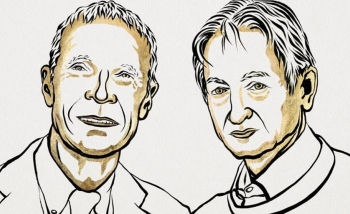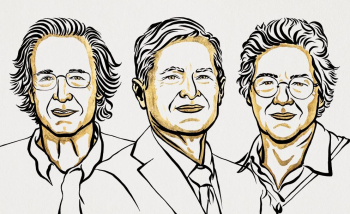It was widely expected and warmly celebrated. Three physicists whose work led to the direct detection of gravitational waves will share the 2017 Nobel Prize in Physics.
Rainer Weiss, Barry C. Barish, and Kip S. Thorne were cited “for decisive contributions to the LIGO detector and the observation of gravitational waves.”
Weiss receives half of the prize, while Barish and Thorne share the other half. The award was announced by the Royal Swedish Academy of Sciences in Stockholm on October 3.
Perimeter Institute Deputy Faculty Chair Luis Lehner, who specializes in strong gravity research, described the Nobel as “wonderful news, and greatly deserved recognition.”
“Thanks to them – and, as they would be quick to point out, about 1,000 researchers and technicians – the gravitational-wave window to the universe has been opened. Major discoveries await thanks to this new lens on the universe,” Lehner said.
“What’s more, we will soon be able to detect both gravitational and electromagnetic waves, providing humankind with information about our universe from multiple cosmic messengers. We are all busily working to exploit this unprecedented opportunity and eagerly anticipating important breakthroughs.”
In the 1970s, Weiss designed a laser-based interferometer to detect gravitational waves, which had been predicted by Albert Einstein 60 years earlier. Weiss, now emeritus professor of physics at Massachusetts Institute of Technology, worked closely with Thorne, now the Feynman professor of theoretical physics at California Institute of Technology, whose theories made crucial predictions of what such an experiment should look for.
Along with Scottish physicist Ronald Drever, who died in March 2017, they launched the Laser Interferometer Gravitational-Wave Observatory. But by the mid-1990s, LIGO was in danger of being cancelled. That’s when Barish, a former particle physicist, stepped in to lead the project to completion.
In February 2016, LIGO announced the direct detection of a gravitational wave.
“Together, they have realised a vision that is almost 50 years old,” the Royal Swedish Academy of Sciences said in a statement accompanying the announcement. “The 2017 Nobel Laureates have, with their enthusiasm and determination, each been invaluable to the success of LIGO.”
Further exploration
About PI
Perimeter Institute is the world’s largest research hub devoted to theoretical physics. The independent Institute was founded in 1999 to foster breakthroughs in the fundamental understanding of our universe, from the smallest particles to the entire cosmos. Research at Perimeter is motivated by the understanding that fundamental science advances human knowledge and catalyzes innovation, and that today’s theoretical physics is tomorrow’s technology. Located in the Region of Waterloo, the not-for-profit Institute is a unique public-private endeavour, including the Governments of Ontario and Canada, that enables cutting-edge research, trains the next generation of scientific pioneers, and shares the power of physics through award-winning educational outreach and public engagement.
You might be interested in


Spiralling light from M87’s supermassive black hole reveals strong magnetic fields
November 8, 2023
